Gars (Gar fish)
This page was born
11/29/2024. It's split off from the original bony fish
page. Last update: 12/12/2024
Images and contents on this page copyright
©2002-2024 Richard M. Dashnau
Go back to my home page, Welcome to rickubis.com
Go back to
the RICKUBISCAM
page.
There
are various species of Gar. At Brazos Bend State Park, I've seen Spotted
Gar, Shortnosed Gar, and Alligator Gar. They are amazing fish, and are a
natural part of our
ecosystems here. That is, they are not "invasive". The largest we
have here, Alligator Gar, can be 8 feet long. I've recently noticed that I
have enough pictures and video
of Gars to give them their own page. So, here they are. I've
captured some interesting activities, and have found information that has
shown me how amazing they are.
10/27/2024
(update 12/04/2024) -- Brazos
Bend State Park. This Gar was cruising next to the Spillway Bridge. I
always hope to see them hunt, so I watched this one. The
spotted pattern was very clear.



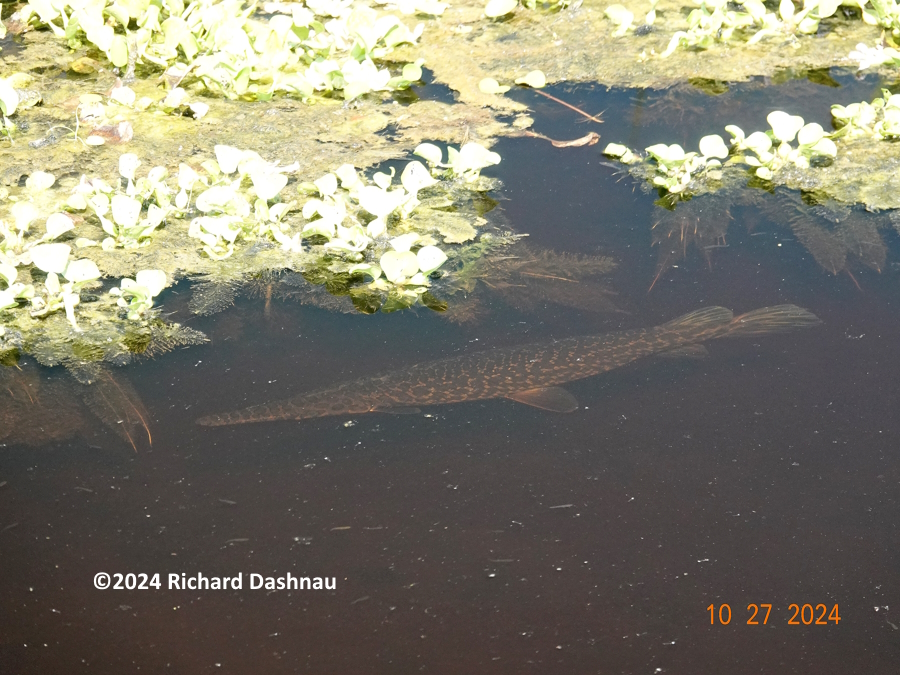
The
ambient light also showed the Gar's eye, and maybe some teeth. No hunting,
but I watched it take a breath. The gas exchange was very quick.



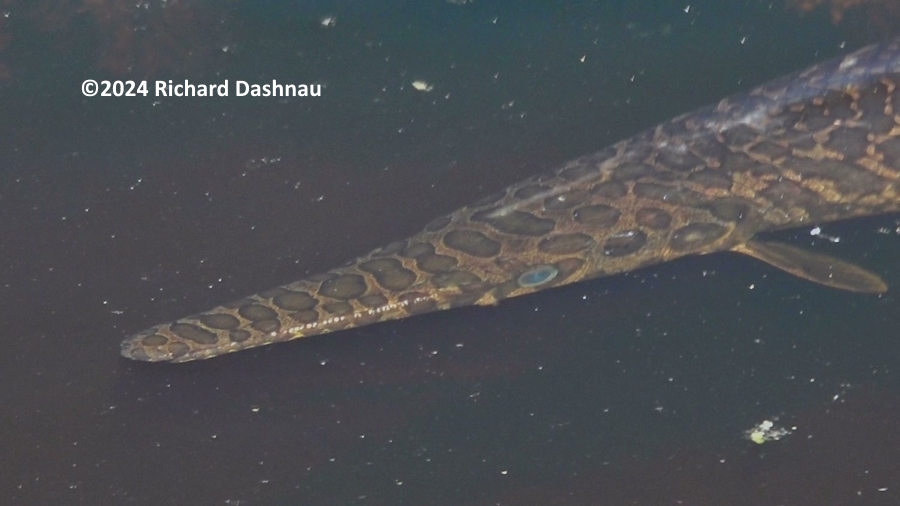
The jaw
clap doesn't always happen. Air from the lung goes into the head
(pharynx). Slight expansion as the snout rises, then lung air vents out
the gill covers in two large bubbles.
Snout goes up further and mouth opens to draw fresh air into pharynx, then
pushed into lung. Gills are flushed with water, releasing a smaller
pair of bubbles.
I've seen the same behavior many times. These
are all frames from the video that I filmed.



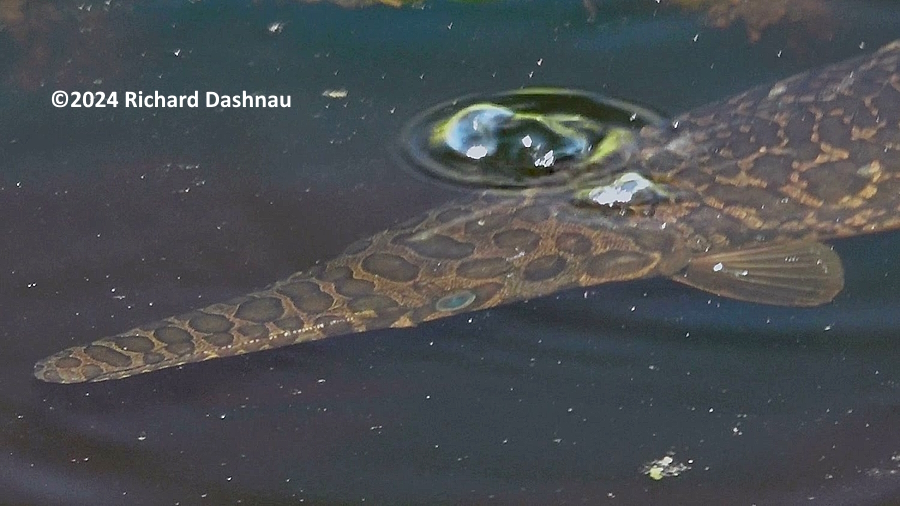
10/20/2024
(update 12/04/2024)
I
was standing
on pier #2 on
Elm Lake Trail
when a very
large Gar
appeared. I'd
seen gars of
various sizes
in water
before, but
I'd never seen
one
moving like
this. My first
guess is that
it's some kind
of maneuver
for grabbing
small prey.
There were
many small
fish around
the gar.
Aside from the
first 2
images, these
are all
frames from
the video I
filmed, which
can
be seen here.




Even though
the glare was
bad, I filmed
this anyway. I
was amazed by
this huge
fish. The
forms of many
small fish
were
contrasted
against the
lighter color
of the
gar. How
long were
the tiny fish?
If they
averaged an
inch
long--then how
long was the gar?
The Gar swam
into shadows
but I found it
a few minutes
later. I've
cropped and
adjusted
contrast in
these images
to
highlight the
Gar. As
I was putting
this article
together, I
found the
paper:
"Feeding
kinematics and
morphology of
the alligator
gar
(Atractosteus
spatula,
Lacépède,
1803)", by
Lemberg et.
al.
(2019).
It is very
detailed, and
describes how
this species
uses "suction
feeding" to
facilitate
prey
capture.
This quote may
explain what
was happening
here:
"
Although gars
are
traditionally
considered
ram-feeders
that only use
suction for
prey
processing,
these findings
show
lepisosteid
feeding
kinematics and
morphology
have been
heavily
influenced by
the need to
maintain
suction while
elaborating a
lateral-snapping
feeding
mechanism."
(p. 20)



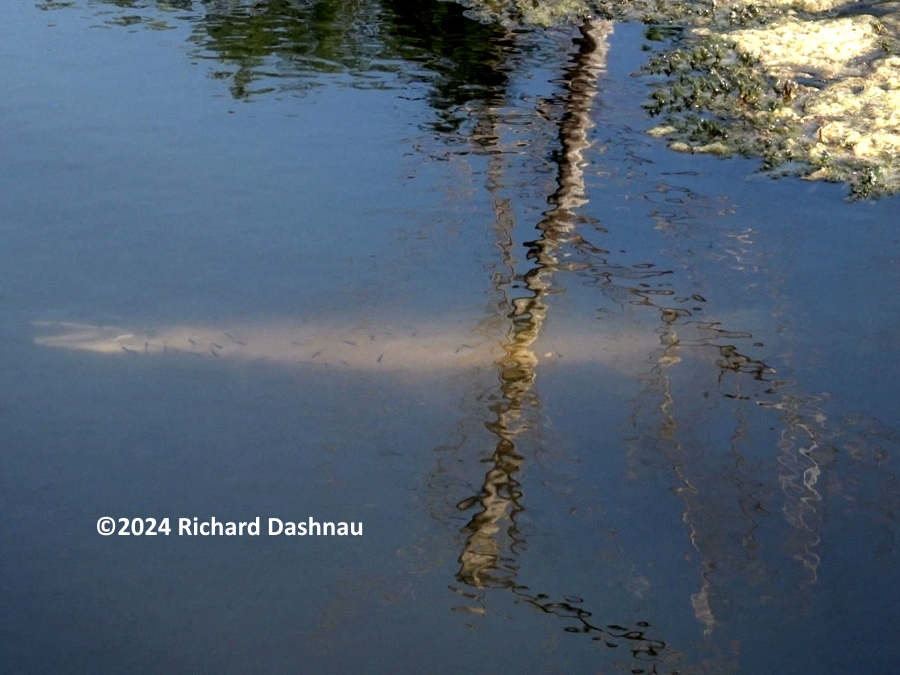
The
Gar reappeared
further away.
I filmed even
through the
glare. I
filmed
continuously,
hoping to
catch it when
it surfaced
for air. And
it did! It
recharged its
lung, showed
its back,
then went back
to the depths
of Elm Lake.
The Gar
breathing
cycle works
like this:
Lung air is
transferred to
pharynx, then
expelled in 2
giant
bubbles.Snout
and mouth
raised to pull
air into
pharynx, then
air from
pharynx goes
into
lung. A
bit later, the
gills are
flushed with
water,
releasing air
from the gill
covers as a
pair of
smaller
bubbles. This
description
comes
from the
paper:
Air Breathing
of the Garfish
(Lepisosteus
Osseus) by
Rahn et. al.
(1971)
The species in
that paper is
the Longnose
Gar.
I have many
more
observations
of Gars on my
Gar
Page.



05/26/2024 (update 12/02/2024) -- Rainfall
at the park had been much less than usual over the summers of 2022 and
2023. Water levels in all the lakes had fallen drastically. Rain
this spring (2024) replaced some of the water. This
gar appeared, and I hoped to see it hunt. It seems to be a Spotted Gar
(Lepisosteus oculatus). It didn't hunt, but I saw it surface
for gas exchange. They always make a pair of huge bubbles when
this happens. Now, I understand how this works. I'll
demonstrate in this slow replay.
Air in the lung will be pulled forward into the pharynx. The
entire skull expands as gas is pulled out of the lung. These are all
frames from the video that I filmed.





Lung gas is expelled from the gill openings. Snout lifts again
before bubbles disperse, to pull air into pharynx. Skull expands
again for this-as first bubble disperses.





As head submerges, the skull narrows as air is pushed from the pharynx
into the lung.





As Gar moves on, the gills are flushed
with water, which often produces smaller secondary bubbles
from under the gill covers. The snout goes up twice.
#1=air out, #2=air in. Then, the small air bubbles.This
is consistent in many videos I've captured over years. I think I've
finally figured out what I've been seeing. This was described
in detail in this paper: Air Breathing of the Garfish (Lepisosteus
osseus) H. Rahn, K. B. Rahn, B. J. Howell, C. Gans and S. M.
Tenney (1971). That is a different species of gar.
This paper is a detailed examination of this species of gar: The
Structure of the Gas Bladder of the Spotted Gar, Lepisosteus
oculatus Jose M. Icardo,Elvira Colvee, Eugenia R.
Lauriano, Gioele Capillo, Maria C. Guerrera, and Giacomo Zaccone
2014





About 40 minutes later, these gars were swimming upstream on the
Spillway between Pilant Lake and Pilant Slough. Water flow is North to
South, into the Slough. Gars will exploit
flooded areas for spawning. I was happy to see these moving into
Pilant Lake, which had been dry. Although most of the smaller gars I see
at BBSP are Spotted Gar, I think the
one in images 3 and 4 below a different species. Examine
the video
clip (mp4) to see all of them swimming against the current.





04/14/2024
(update 12/01/2024) -- This
gar swam past fishing platform # 2 on Elm Lake. The dorsal fin is far
along the back, near the tail. I could see the massive wide head
through the surface glare. I captured video, even though the fish was
mostly obscured by glare. It was at least 4 feet long. Park
visitors were also on the platform. An Apex predator
in this place, a fish this large is will show signs of its passage
through the water. After gulping air at the surface, the gar slowly
turned and showed its back before submerging.
If I hadn't seen the movements before, the slow movement of the dorsal
fin and back would have been easy to miss. Examine
the video
clip (mp4) to see it in action. The video
clip shows the gar as it gulps air. Image 3 and 4 below are frames from
the video showing the expulsion of lung air, and the snout lifting for
the intake of fresh air.




06/05/2021--
I visit Fiorenza Park frequently .
It's pretty close to home, it covers 362 acres, it has about 6 miles of
trails and a wonderful collection of wildlife.
The
weather
was nice, and the high water was apparently enough to induce some Gar to
spawn. I could see one group of gar moving along the surface, and
I tried to capture some video
or photos of them when they gulped air, or came up to the surface.
The water was murky as usual, so I couldn't see much below the surface.
But, I watched them swim over submerged
portions of sidewalk, and over the low footbridge. I didn't get good
photos, and even the frames from the video didn't work well...but some
of the video clips came out ok. I came to realize
that there were more than two fish involved--in fact there might have
been 3 or 4 fish following the leader. I got only a few quick looks at
them from the top--but when I did I saw a really broad
snout. I'm pretty sure that I was watching Alligator Gar (Atractosteus
spatula)! Examine the video clip (mp4) to see them in action. It's
possible that these are Shortnose Gar (Lepisosteus
platostomus), but that broad head makes me think otherwise. When
water temperature and depth is right, gar swim over flooded areas and
deposit stick eggs on vegetation. The males
which are swimming behind, fertilize the eggs. That's what these
gar seemed to be doing.
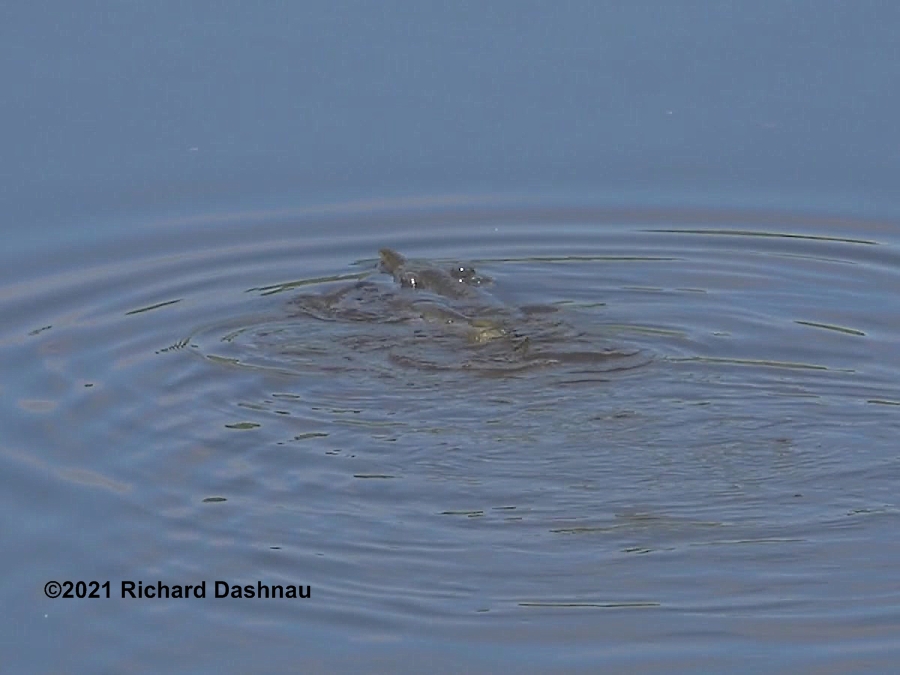
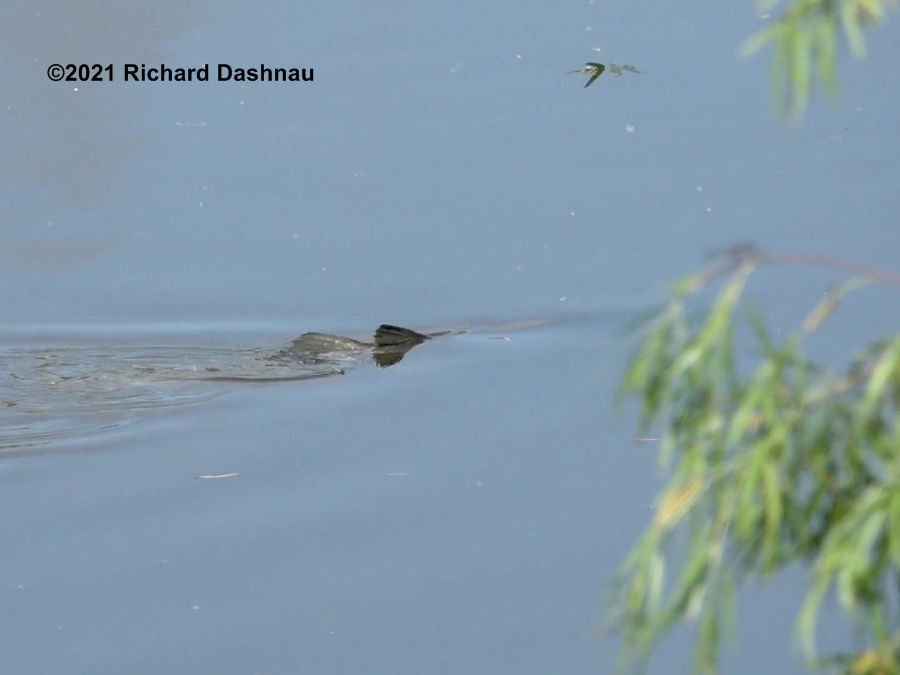
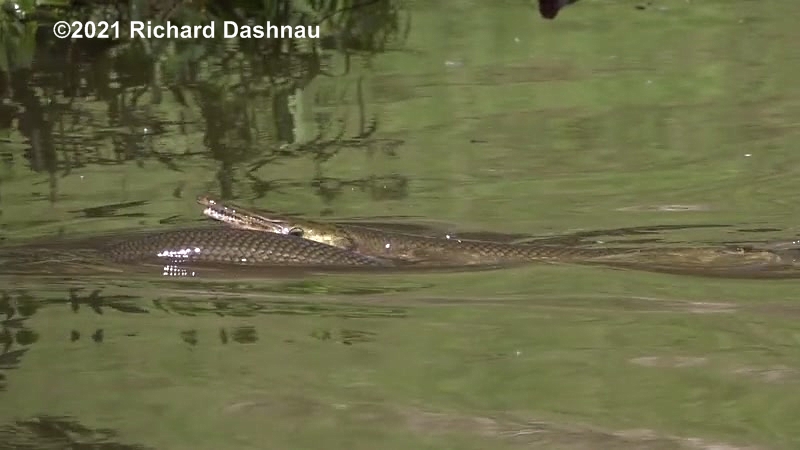

FIRST
VIEW, SWIMMING
TAIL
FINS SHOWING
GETING
AIR--LOOK AT THE TEETH!
MORE TEETH
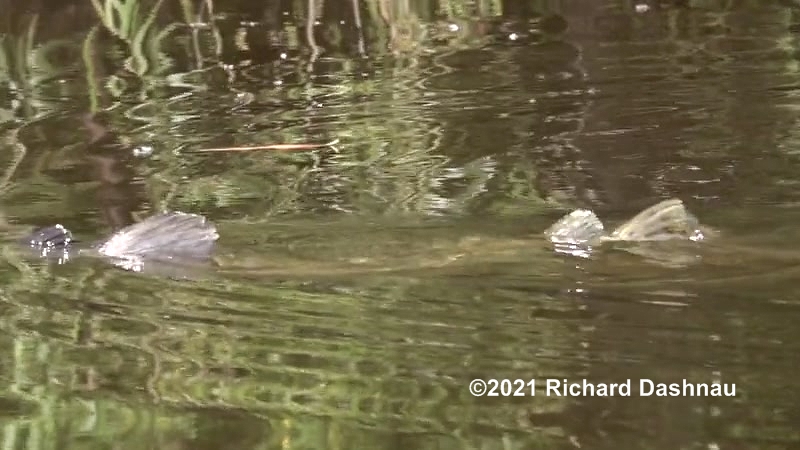


BIG
TAIL ON THE LEFT, FOLLOWED BY SMALLER
BROAD SNOUT VISIBLE
ONE
MORE BREAKING SURFACE
May
24, 2015-- We'd been getting rain, and water levels have
been good at the park. Since it was wet this morning, I decided to drive
down to Elm Lake. When I drove over the floodgate
at the end of Pilant Slough, I looked to my right--at where spillway that
empties into Big Creek. What I saw there made me turn around, go back to
the parking lot at the VC, and return with my
camera. The concrete spillway empties into a gully, which empties
after curving about 300 yards into Big Creek, which flows past and
continues out past Hale Lake and eventually into the
Brazos River. But, at the spillway, the water is relatively calm,
and today it acted as a sort of "lagoon". And there, in the calm water of
this lagoon, a large number of gar were swimming
around. From time-to-time, the gar would come to the surface and--with a
quick up-and-down of their head--gulp air. I estimate that most of
the gar swimming around were 12 to 18 inches
long. We have at least 3 species of gar in the park--Short-Nosed
Gar, Spotted Gar, and Alligator Gar. I was going to try to see if I could
see any Alligator Gar among those in the collection.
Alligator Gar are separated from most other species of gar by a few
physical differences. One of these (and not easily seen) is the *double*
rows of teeth in their jaws. The other, is the
broad, rounded shape to their snout. This broad head resembles that of an
Alligator--which is a reason for the common name. But, it is also
described in their taxonomic name-Atractosteus
spatula (nose broad and flat). I watched in fascination as the gar
moved about. I tried a few times to capture photos or video of them coming
to the surface, so I could get a view of the top
of their heads. It was hard to get these views because the dark water
prevented sighting of a gar until just before it broke the surface. I
wondered if I'd be able to identify an Alligator Gar
among these foot-and-a-half long fish. But, before too long, I had
my answer. Through the circular ripples of the moving fish, I saw a
looming lighter shape under the water. It made its way to
the surface like a submarine, and then broke the surface. As the
head came up, water gushed out from the gill slits on each side. Then the
mouth opened, closed, and submerged. The fish
leisurely followed, and took a while to fully submerge. The head was at
least 8 inches long...JUST THE HEAD. I'd found an alligator gar! Did I
have the camera ready? NO.
However, I continued watching. The large gar were there among the others,
and as time passed, I saw them surface many times. I have no way of
knowing if I was seeing the same Alligator
gar...or the same few gars. But some of them were immense. I could not get
close to the water, to get any certain measurement, but I think some of
the gar could have been around 8 feet long.
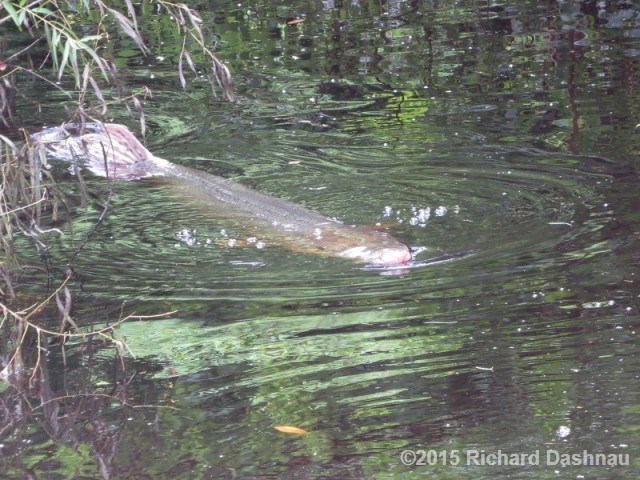





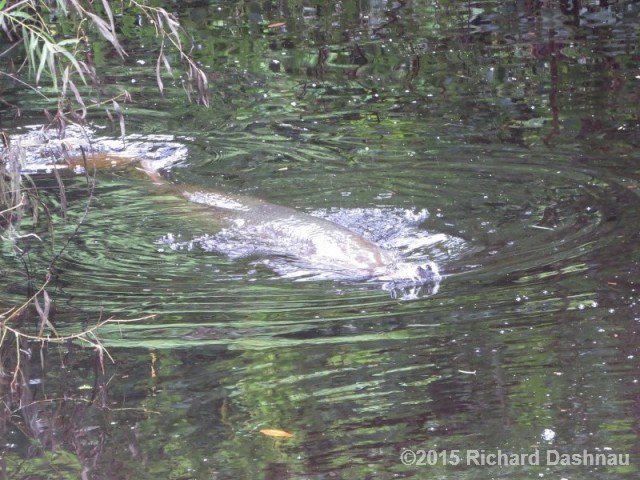

I spent most of the day in that spot, watching those fish. I knew that
this was a transitory, and relatively rare event (we rarely get water that
high, in that spot), so I decided to make the most of it.
I shot many pictures, and short clips, trying to capture some images of
those huge fish...and trying to get some footage that could give some
sense of how large they were.


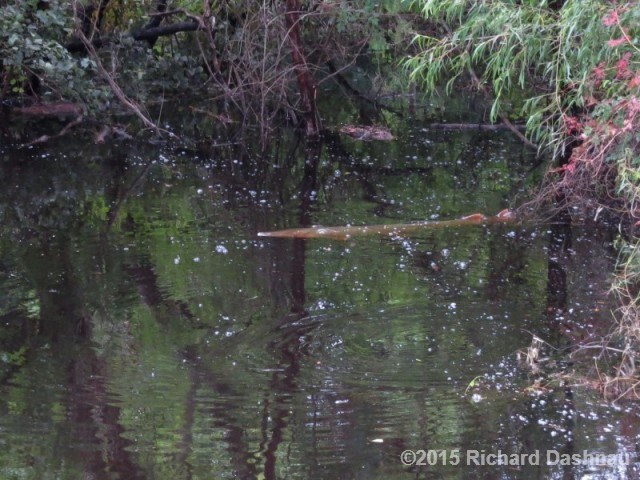


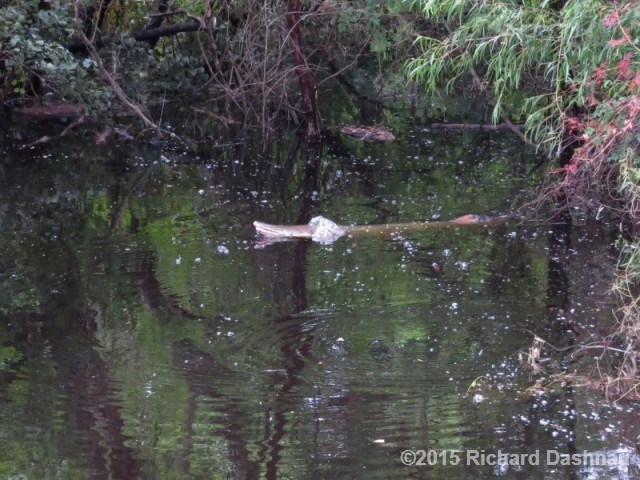
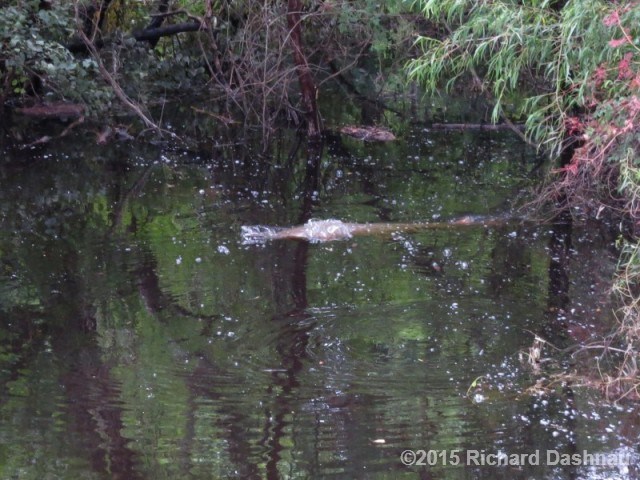

I didn't see anything that looked like feeding behavior. I didn't see any
chasing, I didn't see any "bait" fish. I *did* see what seemed to be gar
swimming in pairs--and a few times one surfaced,
and another surfaced right behind it. All the splashing and activity
finally attracted our other large aquatic predator--the Alligator Gar's
namesake. An alligator appeared from Big Creek. It
was about 8 feet long, and moved leisurely towards the spillway. It
encountered a stick about 5 feet long, and just pushed it along.I happened
to be shooting video, trying to get some scale to
the scene. As I was filming, the alligator suddenly leapt up and
forward. It had gone for one of the surfacing gar, but missed. The
alligator moved back among the wooded cover, and I lost sight
of it. I watched the gar until it was time to go home. I've made two
short video clips from some of the footage. This clip was edited
from footage shot at normal speed (30fps). The alligator
also appears in it: Alligator
Gar
05242015 (mp4 format) The second clip is made from
footage shot at 120 fps, and played back at 30; for slow-motion. These
show the Alligator Gar
gulping air at the surface. Unfortunately for me, while the camera was
adjusted to lower light to "see" the fish under the surface; when the fish
came out of the water, it was overexposed
photographically. I tried to adjust this with software. The slow
motion clip is: Alligator
Gar
05242015 slow (mp4 format)
I'd never encountered anything like an Alligator Gar until a dead one
appeared in the spillway (not the same spillway we have now, but in the
same spot) in 2002. I was able to salvage the
skull from that fish, and I used it to prepare the exhibit that's in the
Visitor's Center now. That skull was about 12 inches long, from
snout tip, to the rear of the head. The carcass-when I finally
found it-was as long as one of our John Deere gators; about 8 1/2 feet
long. Since 2002, many things have changed. The internet has changed, and
perception of the Alligator Gar has
changed. The story of the gar in 2002 can be seen on further down on
this page. Alligator Gar (Atractosteus spatula) have been a reviled,
misunderstood species through much of its natural
range. So much so, that its natural range has dwindled over the years.
Texas is one of the few states with a remaining healthy population of
Alligator Gar, and TPWD has been studing this
fascinating creature to better understand it. That wasn't the case
in the 1930's when a man named J.G. Burr created "The Electrical Gar
Destroyer" and began using it in various bodies of
water. Others emulated him, and thousands of gar were killed (from what I
could find, there is no mention of how many other animals died along with
them). But, things have taken a turn for
the better, and now much more is known about them. One important
fact is that it can take 40 years for a gar to grow to 8 feet long.
Another is that Alligator Gar can only spawn when certain
circumstances occur: there must be ground flooding, and the temperature
must be correct (at least 68degrees). I believe that I was watching
courtship or spawning today--especially when a
pair of gar would surface. As I mentioned, Alligator Gar have 2 rows
of teeth in their upper jaws, with the 2nd row in the roof of their mouth.
They have a "vascularized" swim bladder--which
they can use to collect air and then get oxygen from it. Their skeletal
system has a combination of bone and cartilagenous features--a sort of
crossover from skeletons of sharks and those of
true "bony" fish. Gar are covered with thick, strong ganoid scales. They
are opportunistic predators, and hunt many types of smaller prey, but most
often eat "forage fish" like gizzard shad.
Claims that they decimate populations of game fish (such as bass) have
turned out to be unfounded. Ongoing genetic studies have shown Alligator
Gar to be most closely related to Bowfin
(Amia calva).--which ALSO live here in the park. Alligator Gar are
not only big, but very unique fish. And....they are just one of the
creatures that live here in our park. And I got to watch a
group of them swimming freely right here.
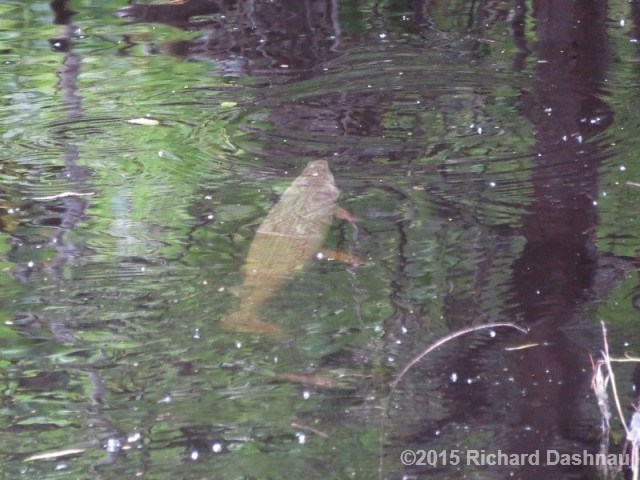
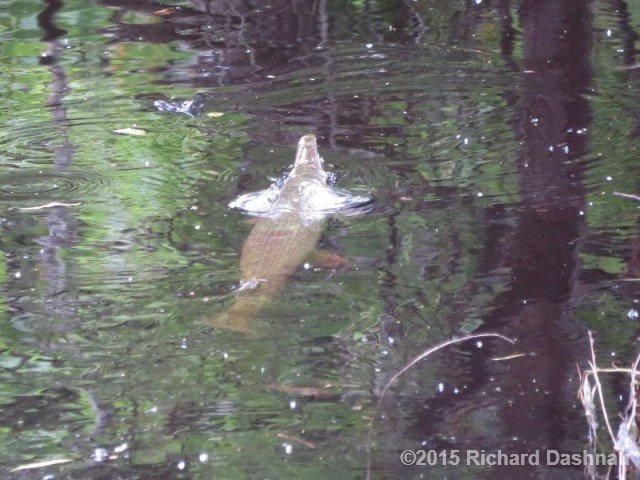


Here are some good links
to information about Alligator Gar:
This article in Texas Parks magazine: http://www.tpwmagazine.com/archive/2015/mar/ed_3_gar/index.phtml
The general description on the TPWD site: https://tpwd.texas.gov/huntwild/wild/species/alg/
and another page here: http://www.fishesoftexas.org/taxon/atractosteus-spatula
There are many other
pages, but these were related to fish in Texas.
July 24, 2011 (added
11/09/2015) And another week later, and the Spotted Gar are still
moving around. I continued shooting high-speed video, hoping to
catch some hunting activity.
I still didn't see any. I did get another clip of breathing. I've
manipulated this clip to show how quickly this happens, and also
to slow it even more.
The 10 images below are frame grabs from this video
clip.










July 17, 2011 (added 11/06/2015) A week later, and the Spotted Gar
are still moving around. I continued shooting high-speed video,
hoping to catch some hunting activity.
But, I didn't see any. I did get a few more clips of them
breathing. This seems to be a 3-step process. First, the
tips of the jaws break the surface and open briefly.
Next, air is expelled from the gill slits--usually in large
bubbles. Then most of the head breaks the surface, and the jaws
open and close again before the head
submerges. As the gar sinks after this, a small trickle of
bubbles leaks from the gill slits. the 10 images below are frame
grabs from this video
clip, which shows 2 surfacing events.


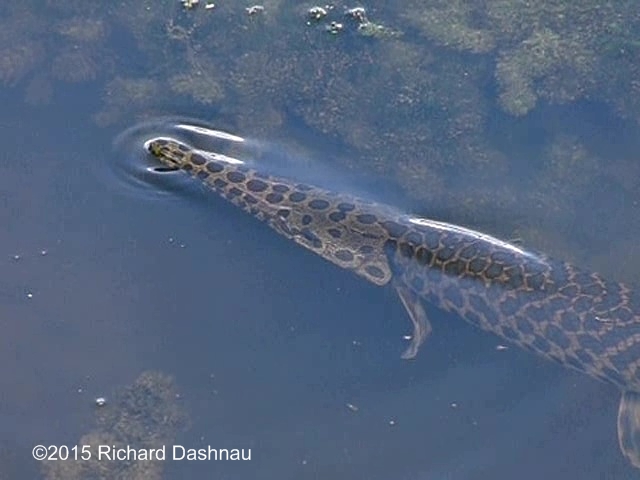





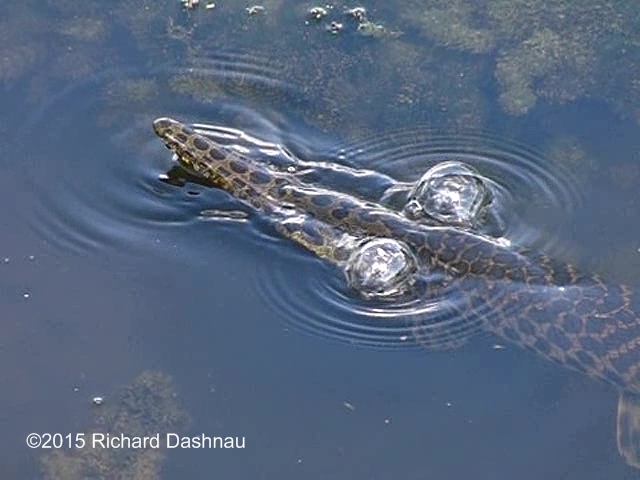
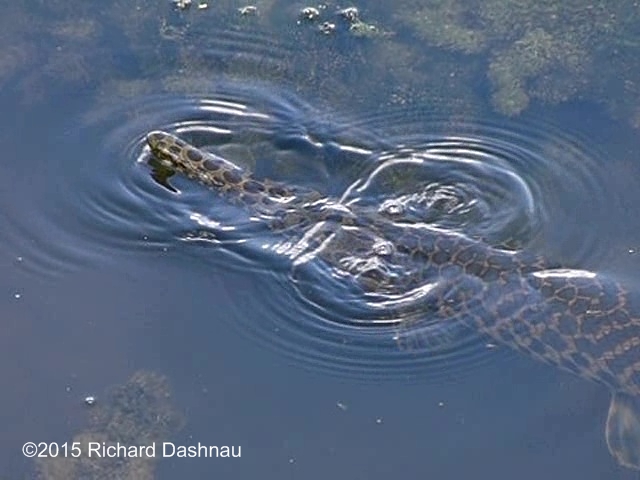
July 10, 2011 (added 11/03/2015) Gar and Bowfin are distantly
related, and both can breathe air. On this day, I was able to see
Spotted Gar (Lepisoseus Oculatus) and
Bowfin swimming near each other. The three images below are frame
grabs from this video
clip. The gar gulps air once in the clip.

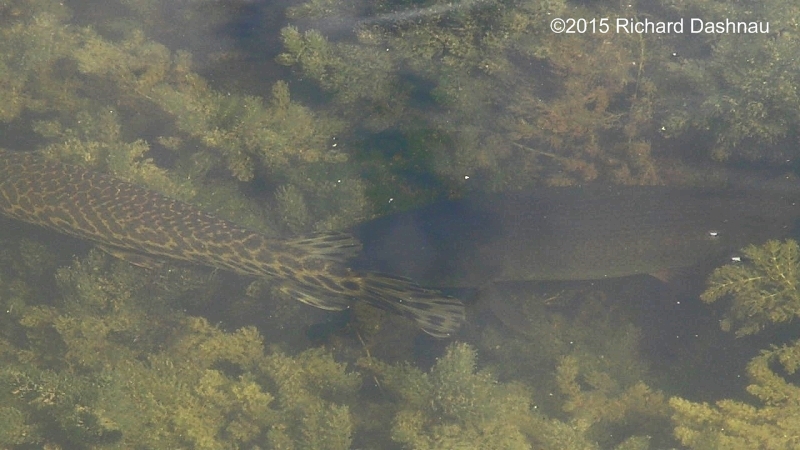
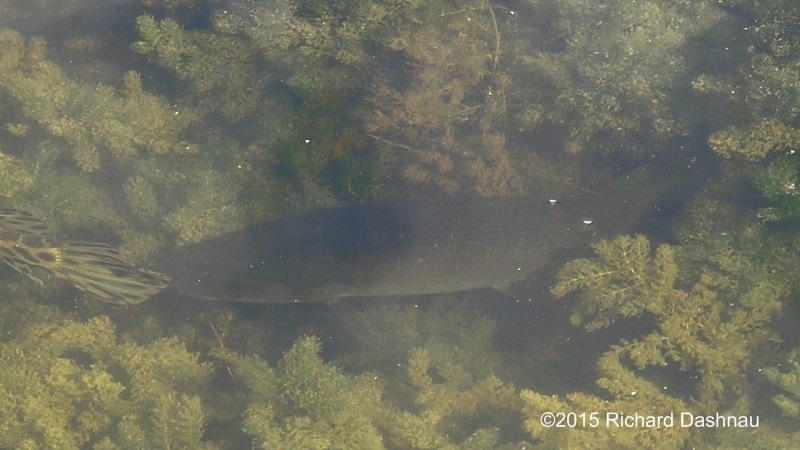
May 3, 2009 (added 10/31/2015)(updated 1/21/21) I watched this gar swimming in
Elm Lake, and was able to film it taking a gulp of air--at 210
frames per second. The images below are frame grabs
from this video
clip(mp4) This is how I usually see gar coming up for
air. They slowly approach the surface, then tilt their jaws out of
the water, open them-then air seems to flush through
the gill slits, and the gar slowly sinks under.

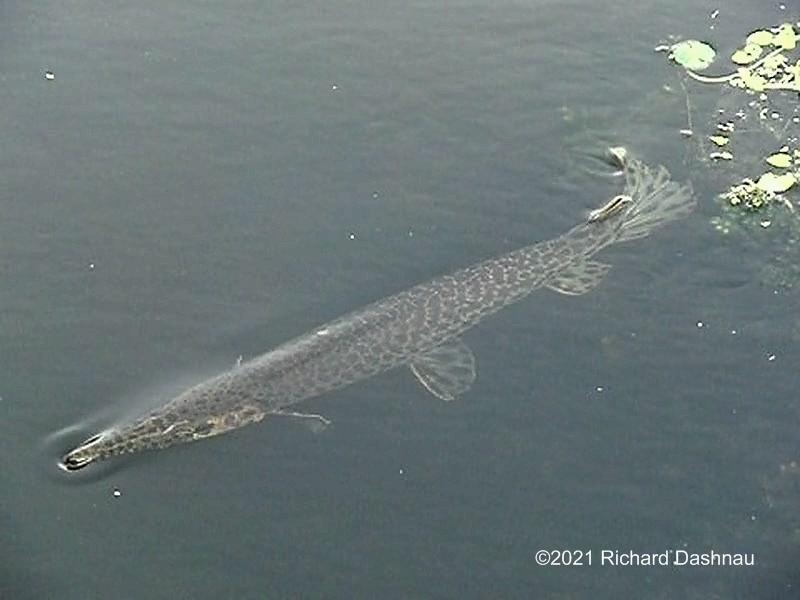
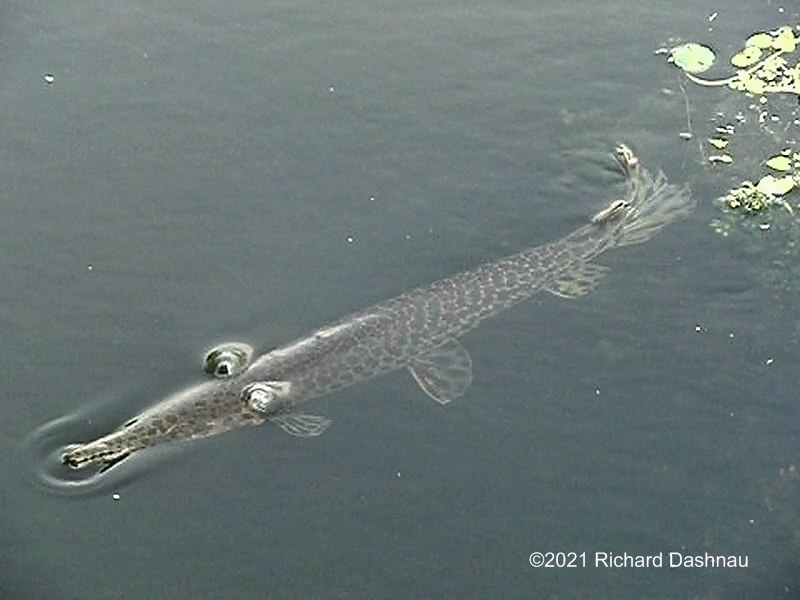

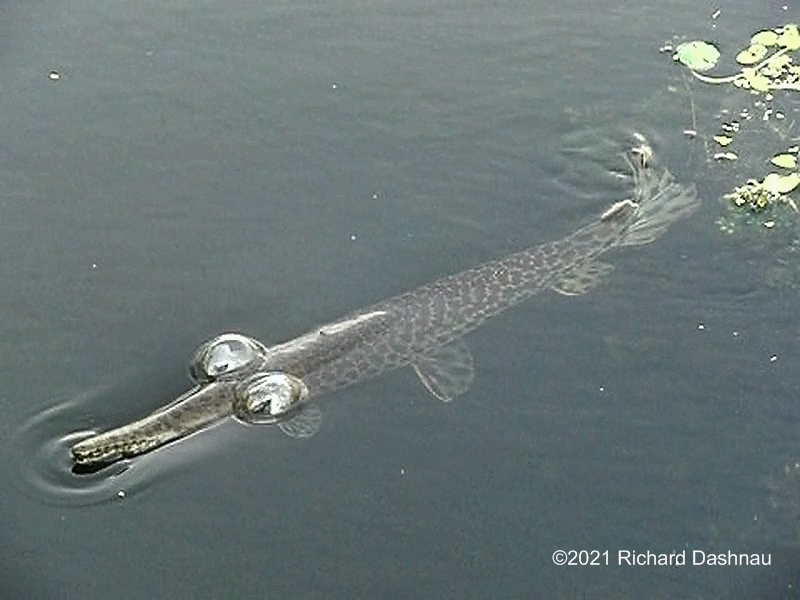
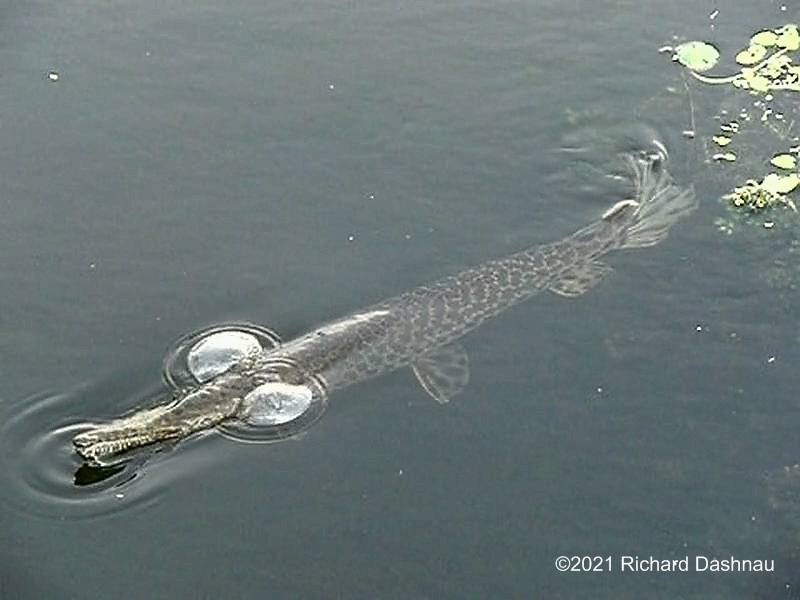
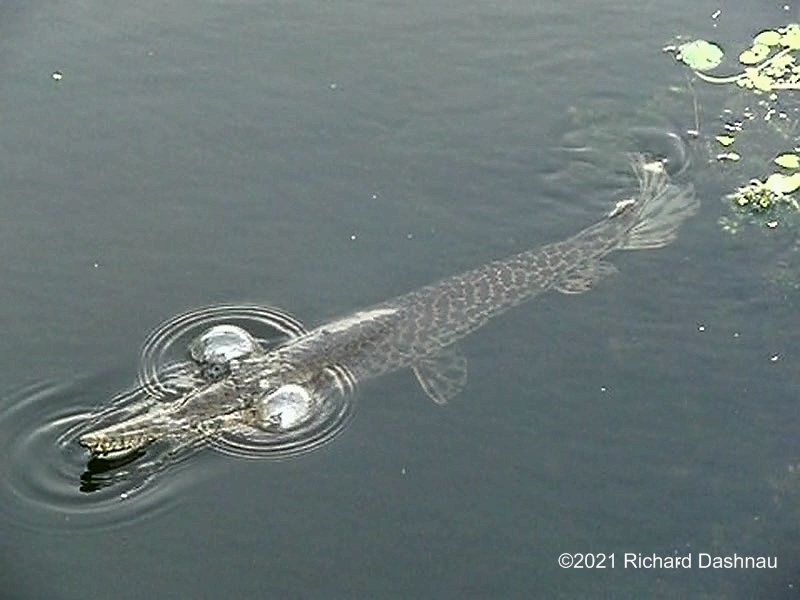


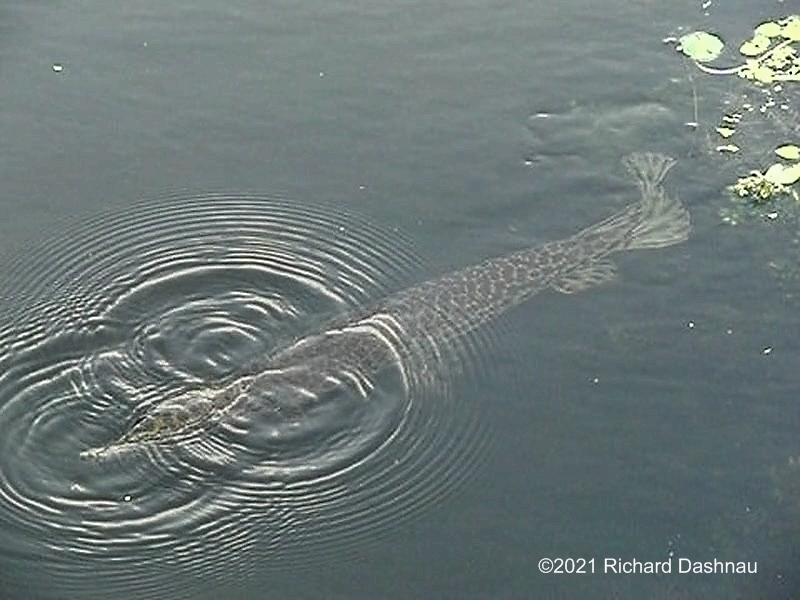
November 10, 2002The image below (BOWFIN) is of an
interesting "primitive" fish called a "Bowfin". The water at the park got very
high. In fact the nearby Big Creek was so filled that
the water from Pilant Slough, which normally flows out of
the park, was flowing back INTO the park from Big Creek. As
evidence of the amount of water we received, here it the fishing
pier on Hale Lake, the deck of which usually stays at least
10 feet above water level (see HALE LAKE PIER, below). This
happened for about 2 days, until the water level dropped in
Big Creek . As the water started flowing back out of Pilant
Slough, other bodies of water were free to drain. 40 Acre lake
started flowing back under the footbridge, and a few predatory
fish stationed themselves in the sluggish flow. Among them
were a few Bowfin, and a few Spotted Gar (see image below).
These fish were about 15 inches long. It is interesting to
me that these "primitive" fish both inhabit the park, right along
with various perch, sunfish and bass. Of course, let's not forget
the
Alligator Gar! The image below (HEAD AND SPINE) shows my completed
gar as it is now.
-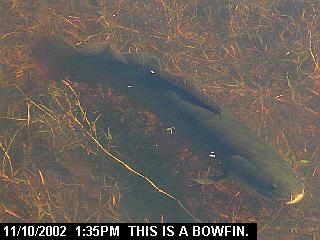 -
- -
- -
-
BOWFIN
SPOTTED
GAR
GAR HEAD AND SPINE
HALE LAKE PIER
October 20, 2002A rather cool, wet weekend.
However, on Sunday, some alligators showed themselves right after
the sun finally came through the clouds. On Saturday, we had
the
Volunteer Picnic at the park. During this, I'm proud to say, I
received an award for "Outstanding Volunteer" from the Brazos Bend
State Park Volunteer's Organization. Apparently, this was
due to votes cast by a number of volunteers. Thanks, everyone! I
have a great time doing things at the park, and then I GET AWARDED
FOR IT! Is that great, or WHAT? The image below
middle (RICKUBIS LIKES FISH) shows some older guy,
Rickubis(yes, that's me), attempting to reconstruct the spine of a
very large Alligator Gar--on the dining room table. In fact, this
is the
same gar I've talked about before. So far, I've gone out on
three occasions to dig and scrape and find these vertebrae. So
far, I've found about 48. I'm not sure how many more there might
be,
but I can't seem to find any more. I'm sure I have a large part of
it. The spine I can reconstruct is about 48 inches ,or 4
feet long. The image below right (LONG SPINE) shows what I have so
far.
Add the length of the head, about 20 inches, and I have 68
inches of a 96-inch long fish accounted for. I have no idea of the
length of the tail spines, nor the distance between vertebrae.
I'll see
if I can get a count of how many there are supposed to be
 --
-- -
- 
FRONT VIEW
-------------
RICKUBIS LIKES FISH-------------
---------------LONG SPINE
September 24, 2002 This series of pictures show the construction of the
display for the Alligator Gar skull. (pictures added 6/3/2015).
 -
- -
- -
-
 -
- -
- -
-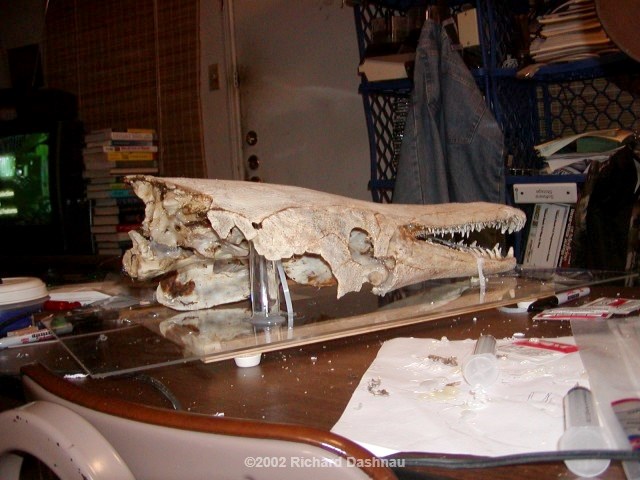
 -
- -
-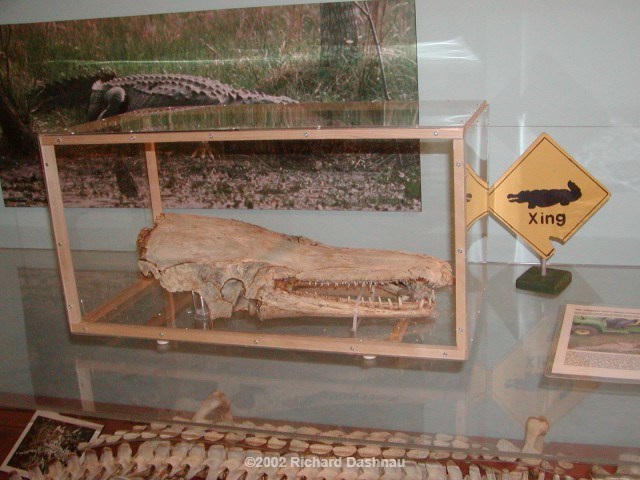 -
-
May 05, 2002
Tuesday,
April
23, I got to the park around 8:00 am. I hadn't been on the trail 10
minutes (I started at the 40-Acre Lake parking lot), when I
encountered a copperhead stretched
across the trail near Hoot's Hollow. I was able to
take a few pictures before it got bored with me and continued across
the trail.(COPPERHEAD, below) Notice the coloration of
the scales
and the shape of the head. Also, the nostril is the small
opening at the tip of its nose. You might notice another opening
between the nostril and the eye. This pit is what gives "pit vipers"
their
name. It's a heat sensor, and aids the snake in stalking food.
Copperheads are poisonous, and as stated in signs throughout Brazos
Bend State Park, "POISONOUS SNAKES EXIST IN
THIS
PARK". The snakes belong in the park. Humans are only visitors
there. Visitors should keep a close eye on their children and pets
while they are in the park, for this reason.
April 07, 2002 Kind
of a quiet day today. More storm weather was due in our area.
However, this morning, I was allowed to join David, one of the
Park Naturalists, and we took a quick
survey of some recently-deceased park denizens. Among them was the
huge gar that I've shown pictures of here, which I'd first
encountered on March 17. I'd wanted to do a quick dissection
of the gar to determine what it might have eaten, but was unable
to find it until today; much too late for this. Making the best of
the situation, I was able to take some more pictures that showed
how large the gar is. Yes, that is a John Deere Gator in the
picture below (By the Gator), next to the gar. I also took
a few pictures of the skull. (MY FOOT (below)) and (TEETH
(below)).
Those teeth are sharp!
-- -
- -
- -
-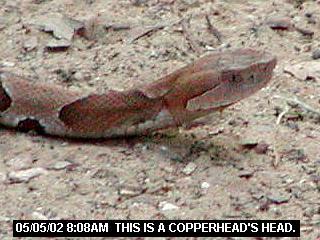
-BY THE GATOR------
------MY FOOT-M
-----
--------TEETH
COPPERHEAD-
March 17, 2002 They were
draining the Pilant Slough, and as the water level receded, aquatic
creatures were trapped in waning pools of water. The alligators
evidently capitalized on this turn
of events, and rested on the newly-exposed banks near the
observation tower in great numbers. See (lots of gators)
below. Then, on the low end of the Slough, where the water was
exiting
the floodgate, a large fish got caught in the concrete breakwater.
This was an alligator gar. See the images below. The first
shot shows it as it was found. I tried to move this fish, but I was
only
able to expose its head, which had been crushed. Note the size
of the concrete uprights. I'm standing on, and you'll get an idea of
the scale of this fish. It was HUGE.
 -
- -
- -
-
--- LOTS
OF GATORS----
---GAR
AS
IT WAS FOUND-
---MY FOOT BY THE HEAD----
------THE HEAD------------

THE ENTIRE FISH
The
Alligator Gar's Story:
In March of 2002, the floodgate at the bottom of Pilant Slough, near the
Nature Center, was opened. This was done to drain the slough so that the
floodgate could be repaired. Sometime
after this, a number of people noticed a huge fish caught in the
breakwater at the floodgate opening. Here is the fish as it appeared
on March 17, 2002.
- -
- -
- -
-
GAR AS IT WAS FOUND---
-MY FOOT BY THE HEAD--
--------THE
HEAD-------
-----THE
ENTIRE FISH
The fish is an
Alligator Gar (Lepisosteus spatula). Note that each one of those
concrete ?teeth? in the floodgate is about one foot across. The gar
was removed and dragged out to a remote
location in the park. Alligator Gars will eat other fish, though it
is reported that they will sometimes take waterfowl. It?s very likely that
a gar will eat anything that it can catch, including turtles
and smaller alligators. Unfortunately, too much time had passed
before this gar could be examined to allow dissection for viewing its
stomach contents. It should be noted here that most
popular game fish, like Largemouth Bass, are generally too vigorous for
the Alligator Gar to catch. Some time later, the condition of the
gar was checked. The plan was to allow various park
scavengers to clean the carcass. Here are other pictures of the gar, taken
April 7, 2002.
-- -
- -
-
---
-BY
THE
GATOR------
------MY FOOT-M -----
--------TEETH
The
gar is pictured near one of the John Deere Gators used by Brazos Bend
State Park. The gar did not break down easily for a number of
reasons. A hot, dry summer and the heavy scales
covering the body probably prevented effective scavenging of the
carcass. On April 23, Park Volunteer Rick Dashnau salvaged the
head and developed this project. The gar?s head was
kept in the specimen freezer for some weeks while Rick and the Park
Naturalists tried to figure out how best to clean it. What made
cleaning this prize so difficult was its size. It barely fits into
a five-gallon bucket! On August 7, a small cage was built (to prevent
larger scavengers from disturbing the head), and the head was placed
in an ant nest for further cleaning. Finally, the skull
was clean enough to work with. Rick Dashnau was able to finish
cleaning and preparing the skull, and also able to build the case to
display it on September 24, 2002.
I'll note here that we measured one of these John
Deer gators today. It was 8.5 feet long! Also, here are four more
pictures of the Alligator Gar. The first one (ANT CAGE)
shows the cage I
built for the head so I could place it in an ant nest. The next
two (STILL NOT, and 12 INCHES) show the head after the last
treatment; a week long bath in a solution of 1 gallon bleach/4
gallons
water. This was before I stripped off the remaining flesh.
The measurement is from the end of the snout to approximately the
center of the eye socket. These were taken on September 19th...
the same day as my images of the 3-fanged Cottonmouth. The
next two (SIDE VIEW, FRONT VIEW) are of the gar's head as we first
displayed it. We placed it on top of the display featuring
the skeleton of an 8-foot long alligator. What I can't stop thinking about
is the image of this huge prehistoric fish stalking the waters of
the park--as large and as voracious as a good-sized
alligator!
 -
- -
-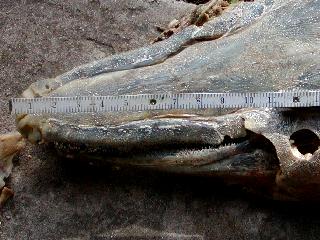 -
-
08/07/02 ANT CAGE
8STILL....NOT
QUITE
12 INCHES
TIP TO EYE
SIDE VIEW
The gar
is pictured near one of the John Deere Gators used by Brazos Bend
State Park. The gar did not break down easily for a number of
reasons. A hot, dry summer and the heavy
scales covering the body probably prevented effective scavenging of
the carcass. On April 23, Park Volunteer Rick Dashnau salvaged
the head and developed this project. The gar?s head
was kept in the specimen freezer for some weeks while Rick and the
Park Naturalists tried to figure out how best to clean it. What
made cleaning this prize so difficult was its size. It barely
fits into a five-gallon bucket! On August 7, a small cage was built
(to prevent larger scavengers from disturbing the head), and the head
was placed in an ant nest for further cleaning. Finally,
the skull was clean enough to work with. Rick Dashnau was able to
finish cleaning and preparing the skull, and also able to build the
case to display it on September 24, 2002.
Go
back to my home page, Welcome to
rickubis.com
Go
back to the RICKUBISCAM
page.
Go
back to the See
the
World page.







































































































 -
- -
- -
-
 --
-- -
- 
 -
- -
- -
-
 -
- -
- -
-
 -
- -
- -
- -
- -
- -
-
 -
- -
- -
-

 -
- -
- -
-
 -
- -
-
 -
- -
- -
-